By Mr. TWS
Budapest’s District 8
Until recently, Budapest District 8 was off the radar for visitors, considered a high crime area with buildings in various stages of disrepair from neglect. It’s still not a place that tourists will find easily.
Just as in other places we’ve visited, we were really glad we carved the time out for a Context Travel walking seminar. During our “Barons of Budapest” tour, we were introduced to District 8 which is known as the Palace District. We would not have stumbled upon this area or learned the stories and history of the area on our own. Our informed and friendly guide, Eniko Békés, a Budapest native with a Master’s degree in art history and a PhD in Neo-Latin Studies, has an enthusiasm for the topic which was also an important part of the tour.
The palaces of District 8 are not the royal palaces that you think of when visiting many places in Europe and the barons are not the barons of nobility, but instead were more like the aristocratic “railroad barons” of the U.S. That is, they were people of wealth, power and influence mostly without noble bloodlines. Their time in history was the latter part of the 19th century, when Hungary assumed its elevated position among countries in the Austrian Empire as it became the Austro-Hungarian Empire in 1867. During this time, the wealthy families of Budapest were trying to build residences modeled after the grand mansions of Vienna and Paris. Many of these structures in District 8 were destroyed in World War II. Some were designed by architect Miklós Ybl who also designed other landmark buildings in Budapest, including the Hungarian State Opera and St. Stephen’s Basilica.
There’s lots of interesting history that I won’t cover in this post; instead my main objective is to show some of the exterior architecture and magnificent interiors of a few of the buildings we toured as well as other sites along the way that we found interesting.
We began our walk in front of the Hungarian National Museum on Múzeum körút. The steps pictured are important in key historical events, such as the Hungarian Revolution against the Austrian Empire in 1848 and annual events commemorating the revolution. Additionally, before the construction of the current Hungarian Parliament, the members met in this building.
As we turned off the busy Múzeum körút to go deeper into the Palace District, we began to see a different side of Budapest.
It was nice to learn that many of the residential palaces of the area are being restored and used for functional purposes, such as government buildings, contributing to the general gentrification of this historical center of Pest (the city on the east side of the Danube that was joined with Buda on the west side to form Budapest). As a result, we were only able to see the exterior of some of the buildings, such as Dessewffy Palace pictured below.
The Italian Institute of Culture on Bródy Sándor utca pictured below gives a hint of the original splendor and the opulence of buildings in the Palace district. The building was designed by Miklós Ybl and was the seat of the House of Representatives of the Hungarian National Assembly between 1865 and 1902. In front of the building is a bust of Giorgio Perlasca, who was an Italian who saved thousands of Jews during the Holocaust.
It was interesting to see rows of these houses clustered together along city blocks. Typically, there had been an initial building and then the others eventually filled in. The first light building as you move leftwas the original Parliament building.
I liked the unusual façade of Gschwindt Palace building with its unusual clock just above the two windows on the right.
The elaborate staircase pictured below is located in the former Festetics Palace, originally belonging to one of Emperor Franz Josef’s ministers. It is now Andrássy University, the first German-speaking university in non-German-speaking Central Europe.
The former ball room is used as a large meeting room but even with the modern chairs the beauty of the interior prevails. The many mirrors, the elaborate chandelier and the ornateness of the windows, walls and ceiling were my favorite parts of this room.
This impressive building is one of three Károlyi Palaces. The building to the left of it is a remnant of the communist era built in the 1960s on the site of the Hungarian National Stables, demolished after World War II.
The most impressive building we toured was the Metropolitan Ervin Szabó Library, formerly Wenckheim Palace. It would be hard to come up with an excuse for not going to study in a library that is this amazingly beautiful. However, once there I can imagine it would probably be difficult to concentrate on studies in such a setting. Below are pictured some of the highlights.
This atrium is in the lobby area of this magnificent library.
This painted dome ceiling and spiral wrought-iron staircase in another District 8 building are further examples of the opulence of Budapest’s Golden Age.
Another site that played a big part in Hungarian History was the Magyar Radio building, the flash point of the Hungarian Revolution of 1956 against the government of the Soviet People’s Republic of Hungary and its policies. It began as a student revolt and when the students attempted to enter the state-owned radio building, the police fired on the crowd killing several.
The names of those who died are etched on the plaque between the two windows on the left. The flag pictured, symbolizing the 1956 Hungarian Revolution, has a hole in it where the communist coat of arms was cut out.
Not all of the construction in District 8 is preservationist and restorative. In the photo below, the original fence of a 19th century palace was preserved but behind it is a modern glass building. Notice also the “attractive” elevator sticking up in front of the fence. Fortunately, this was a rare sight in the area.
The Palace neighborhood of Budapest District 8 gives you a different perspective of the city and its history.
Thanks to Context Travel for hosting our walk.
Editor’s note: Please check the Context Travel website as tour options and itineraries may change.

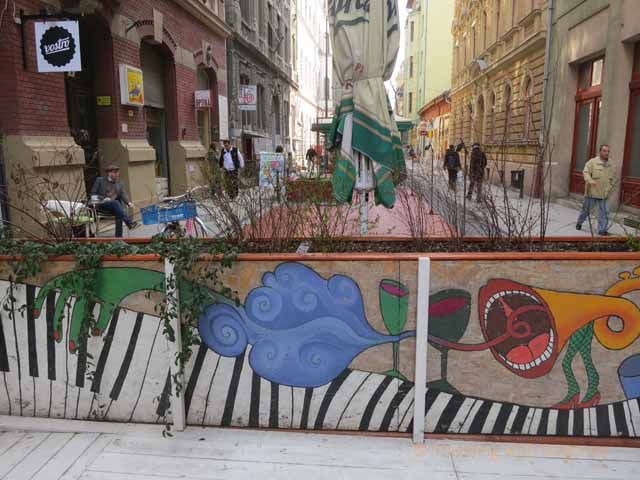

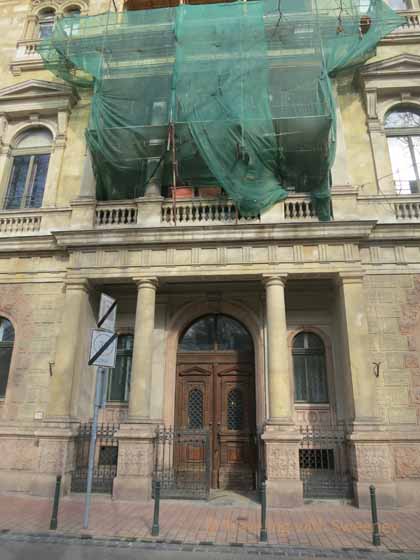


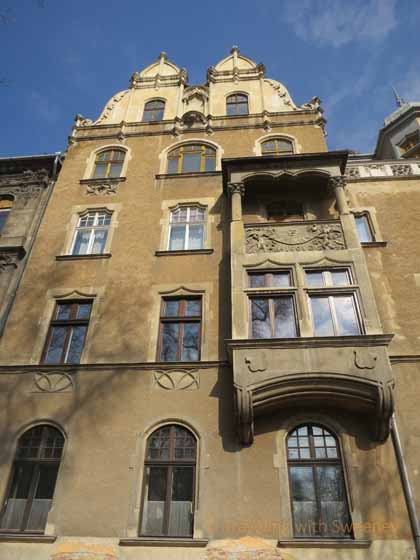
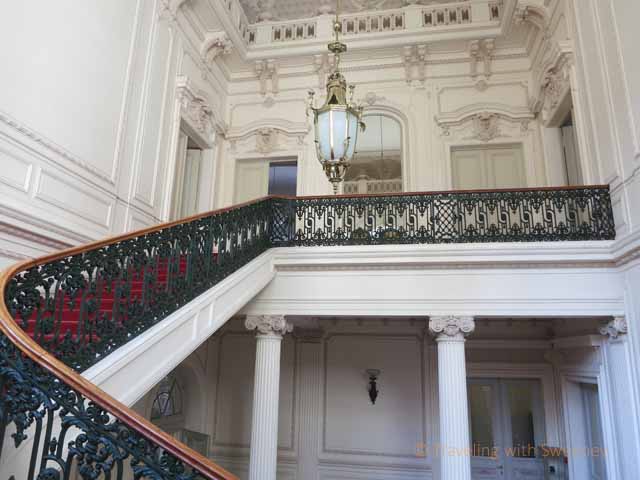
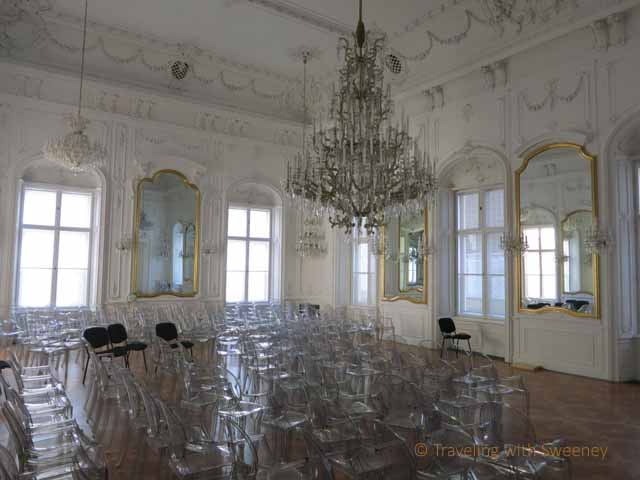
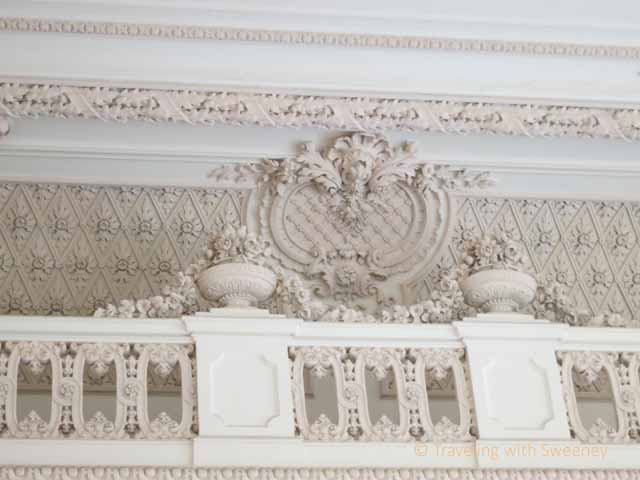
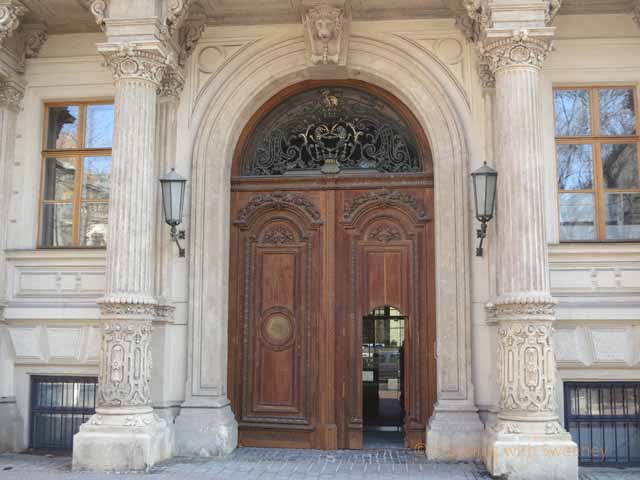
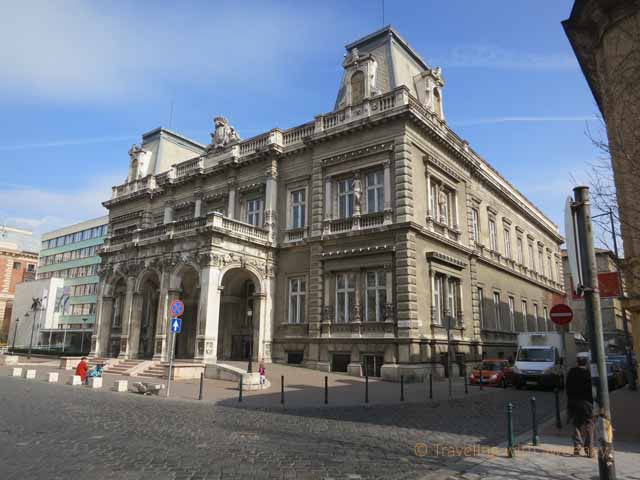


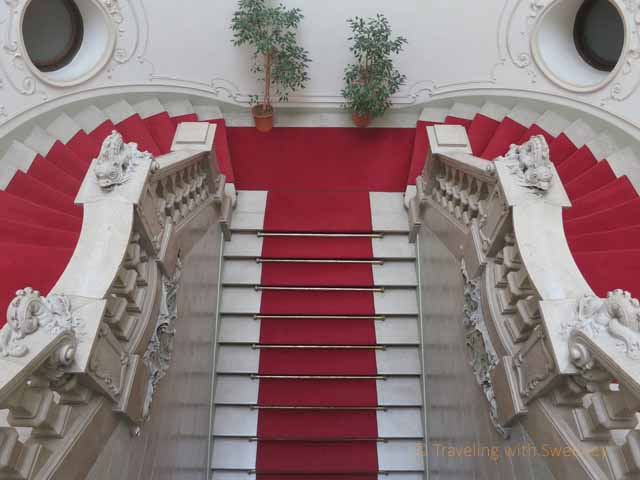


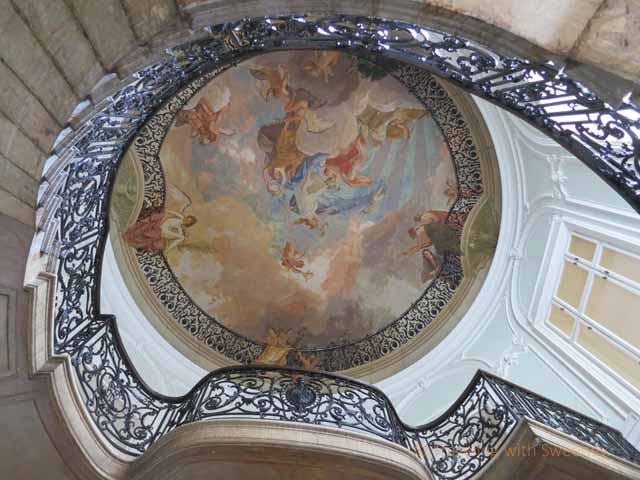


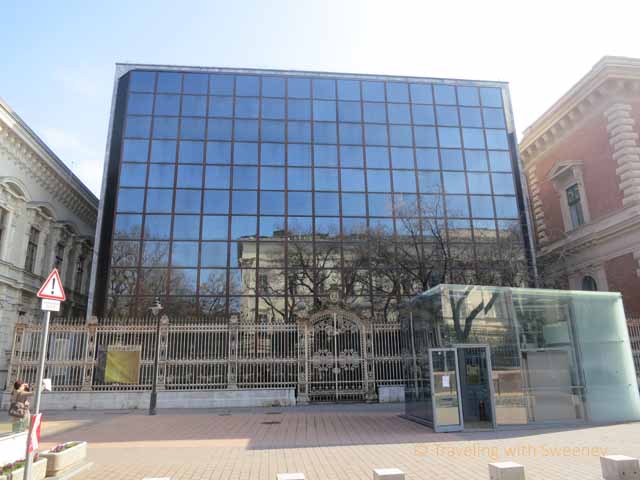

I feel like Cinderella in the ball room. Such amazingly detailed architecture. Nice to see it renovated instead of more modern glass. This was a great tour.
Thanks for the comments. We really liked the tour and I can’t agree more. I hate to see old buildings destroyed, even when replaced with new buildings that look of the same period and blend with the old better than modern and especially ones like the one pictured.
Day tours or half day tours are certainly the way to find the places and get the facts. Exterior of Gschwindt Palace is my favourite photo. I don’t think I would get much study done in the Study area in Metropolitan Ervin Szabó Library. I am sure I would be focused on the ceiling, walls and views 🙂
Thanks for the feedback. I also had a close-up of the window of Gschwindt Palace that showed the odd clock better. Similarly with the museum I had closer pictures of just the ceilings, walls and stairways that showed the detail better. Maybe I’ll include some of these in a follow on. I’ve never been in a library that beautiful, not even close.
Wow, magnificent is an understatement! Each building is more fabulous than the other. I can’t believe this area with these amazing buildings was off limits. Glad it’s coming back.
It’s really great they’re being restored and the area is being improved. Thanks for the commens.
Now that’s a library I could spend some time in. What a gorgeous space. And I love all the architectural details.
I would definitely go back to the library when we go back to Budapest, even with the other things we didn’t see. Thanks for commenting.
What an interesting area of Budapest! We’ve visited 3 times yet haven’t been to this district. I’ll definitely have to check it out on our next visit.
There are things on line and other sources to direct you but I would certainly recommend the tour. Thanks for the comment.
Wonderful tour, Cathy. I didn’t get to this section of the city when I was there. It’s on my list for next time!
Hopefully you’ll get back to Budapest soon (hope we do too); the tour would be worth the time but even just strolling the area and checking out the library and university would be worth it. The synagogue, market, Liberty Bridge, Cave Church and Gellért Hill and Gellért Baths, et al are nearby. Thanks for commenting.
I love that library and its curved staircase. I also like the street art in the first photo. I love coming across things like that.
The wooden spiral staircase was my favorite with that amazing ceiling second, but the building throughout had diverse beautiful features. Sweeney really likes street art also. She has got me really paying attention and enjoying it. She directed me to take the photo. Thanks for commenting.
What a fabulous tour! It’s interesting that this area is not on the usual tourist path. With magnificent buildings such as the library and others being restored, I would have thought that this was a popular area.I must remember to vist District 8 when I finally get to Budapest.
Thanks for the comments; I think the recent gentrification will help a lot and the Context Tour will get the word out. After the fact, we did see things suggesting seeing the area but unlikely we would have come across without having known of the tour.
Wonderful architecture. That library is amazing and I love the street- wall murals.
I had numerous pictures of the area that showed other beautiful and interesting art and architecture. Probably enough for a short add-on post. Thanks for commenting.
I do have admit, Budapest looks really nice; really like the architecture. Glad you had a fun tour!
We had high expectations for Budapest that were exceeded on this first visit. Definitely on our list for returns. Thanks for the feedback.
*gasp* The detail! Not just interior details but all the fine, small details on the exteriors – beautiful.
They just don’t do that anymore.
They certainly don’t. I expect even the restoration of these buildings must be very expensive. They certainly rivaled real palaces we’ve seen elsewhere.
This really is a great tour and you’ve got me convince about Context Travel. Tour guides with great knowledge and enthusiasm for their subject make a big difference. The Ervin Szabó Library is stunning. You’re right, it would be hard to concentrate studying in such a beautiful place.
I’m really glad to hear your comment about Context. You won’t be disappointed. We’ll definitely visit the library on our next trip to Budapest.
Cool photos. Loved that staircase composition the most !
Thanks so much for the comment. I’m glad you enjoyed.
We missed these – gorgeous and interesting! So much to see and do in Budapest
We’ll definitely find a way to get back. Hope you’re able to get back. This area is well worth some time and near other key sites.
I’ve walked in this neighbourhood once, not knowing much about it, just aimlessly wandering, as I often do. (I remember the sign on the wall of Magyar Radio). A Context tour next time, for sure.
We like aimlessly walking too but I think it’s definitely worth getting a Context Tour and saving the solo strolls for areas the tour doesn’t cover. Thanks for the comments.
A well detailed article, Mr. TWS! Love the photos and how detailed these buildings are. Metropolitan Ervin Szabó Library sure seems like a place to go. I’d be taking photos rather than reading there 🙂
If we weren’t on a tour, I would have kept taking pics. Thanks for the comments.
Love discovering areas that most tourists skip. I’m with Leigh, I could spend a lot of time in that library.
So do we. Context certainly helps. We’re trying to do a better job of pre-planning to find more of the undiscovered. Sometimes it’s just serendipity.
Very informative travel article thanks to some very good images which have been used very efficiently to add to the lucidity of the post. Loved the photo of Staircase in Andrássy University and use of the leading line which add to the depth of the image.
Thank you so much for the comments. I’m really happy you enjoyed.
Wow, beautiful buildings! It’s surprising to think that an area with such great architecture that presumably was a very wealthy neighborhood then became a spot tourists didn’t go, but I guess it just shows how cities evolve. I’m glad it’s getting cleaned up and that you were able to see it.
Thanks for the comments. Hard to believe that buildings like these would fall to disrepair but great that the trend now is to save them. Sad to see when they’re torn down and replaced with modern buildngs.
Pingback: 5 Reasons I Went Back: Budapest Highlights » Traveling with Sweeney
I missed this post first time round, but have come to it now after seeing that library shot on Facebook. I’ve enjoyed viewing the whole photo series here, and those library interiors are real standouts.
Pingback: Giving Thanks in 10 Languages
Pingback: Giving Thanks for Travel in 11 Languages | Traveling with Sweeney
Pingback: Giving Thanks in 16 Different Languages | Traveling with Sweeney